Up Next
How Pakui Hardware Grafts the Medicinal Industry Onto Their Surrealistic Art
The Lithuanian duo is presenting one of the buzziest national pavilions at the Venice Biennale.
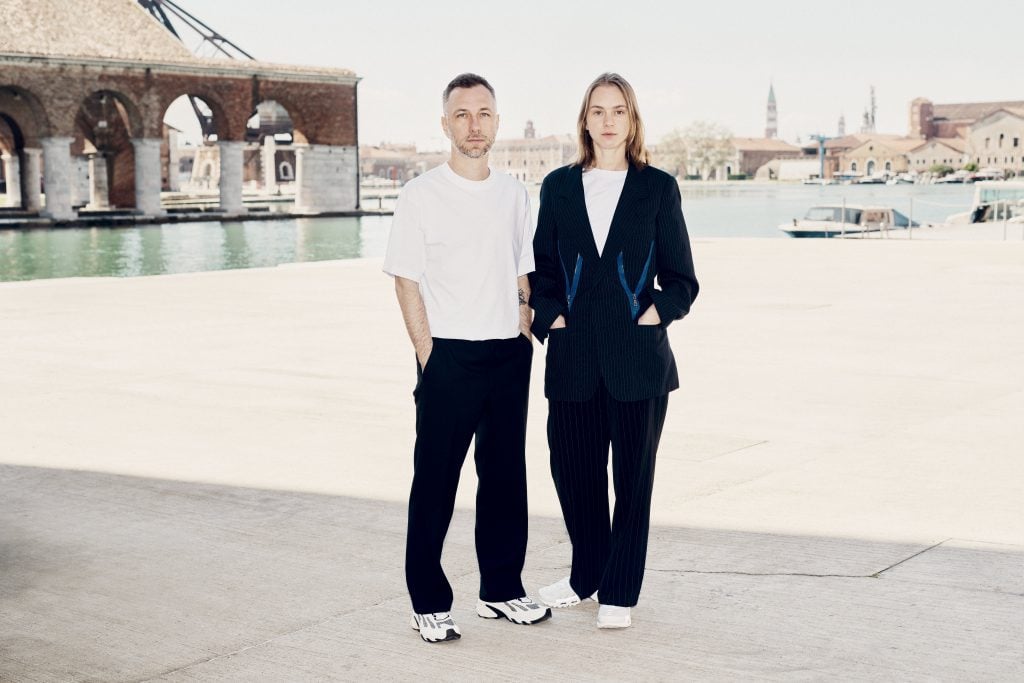
The Lithuanian duo is presenting one of the buzziest national pavilions at the Venice Biennale.

Devorah Lauter

The emerging artist duo Pakui Hardware were putting the finishing touches onto their installation for the Lithuanian national pavilion at the Venice Biennale, located in the Chiesa di Sant’Antonin, when I met with them shortly before the opening.
A warm orange light shone through the windows of the church, setting Neringa Černiauskaitė and Ugnius Gelguda’s sculptures aglow in what felt like a fortuitous, celestial benediction of the exhibit’s theme around inflamed, feverish bodies, and ailing systems. Yet, as with all of the duo’s carefully crafted, site-specific artworks, which have been attracting growing curatorial attention, the lighting effect around the work, which is suitably called Inflammation, was no random coincidence.
The young, Vilnius-based artists work in a kind of dance, they said. One where everything, down to the smallest details, is done together in a pas de deux that leans on the best of each of their differing talents. Černiauskaitė has a curatorial background and does most of the talking about concepts, while Gelguda is the form-maker who studied photography, media arts and is “more practical, visual.” Their combined abilities as Pakui Hardware has helped drive a string of ambitious, much-lauded exhibitions in recent years. With their Venice debut, that recognition is only set to grow.
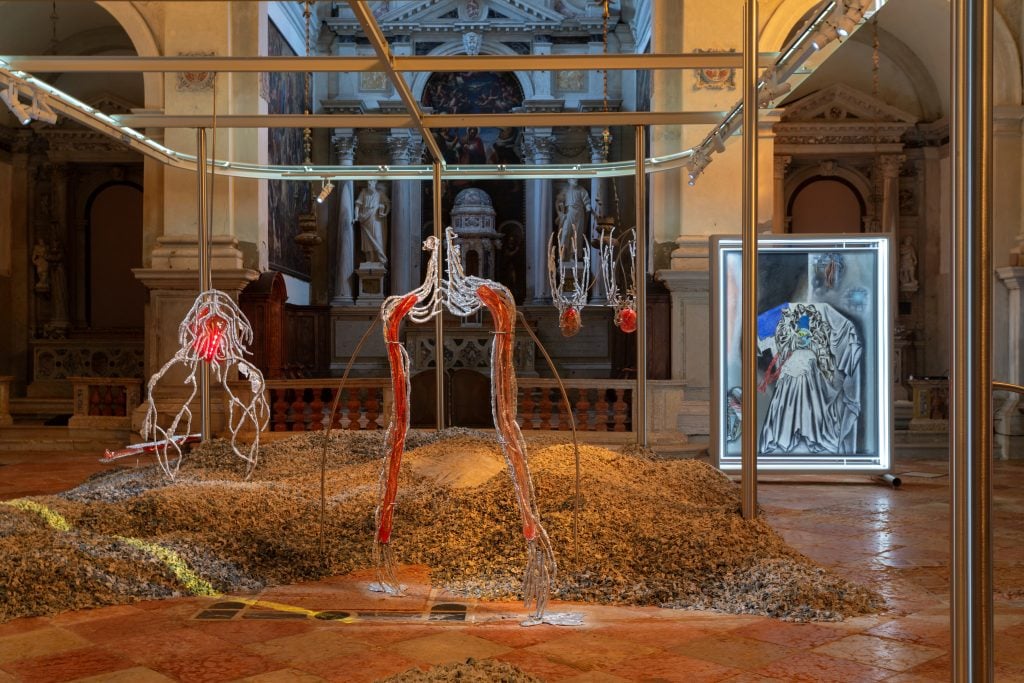
Pakui Hardware and Marija Terese Rozanskaite. “Inflammation.” Lithuanian National Pavilion 2024. Photo: Ugnius Gelguda. Courtesy of the artists, Lithuanian National Museum of Art and carlier | gebauer (Berlin/Madrid), MTR art foundation
In the works, one often finds large-scale, glass organs suspended or lying on tables, hooked up to rubber tubes in clinical settings that claim to heal, regenerate, or enhance. The artists are interested in fleshing out the unlikely subject of the contemporary medical sphere as a metaphor, and they interpret its interventions in poetic renderings of bodily systems of nerves or veins, sculpted in all-encompassing installations, that become worlds of their own.
And though it needs no explicit explanation, the pair draw a direct parallel between how scientific processes specific to our own bodies are similar to what has been done to our planet—in a race to produce and engineer new growth, or cheat death, systems are squeezed for what they are worth.
Their name itself has conceptual roots, too. Pakui refers to a special attendant of a Hawaiian goddess, who ran around the island six times a day as part of her devoted service, while Hardware refers to “materiality, bodies, and resources,” per the artists’ website. As with their contrasting skills, the duo straddles these two opposing realms, juxtaposing the synthetic and technical, as well as mystical, and mythological.
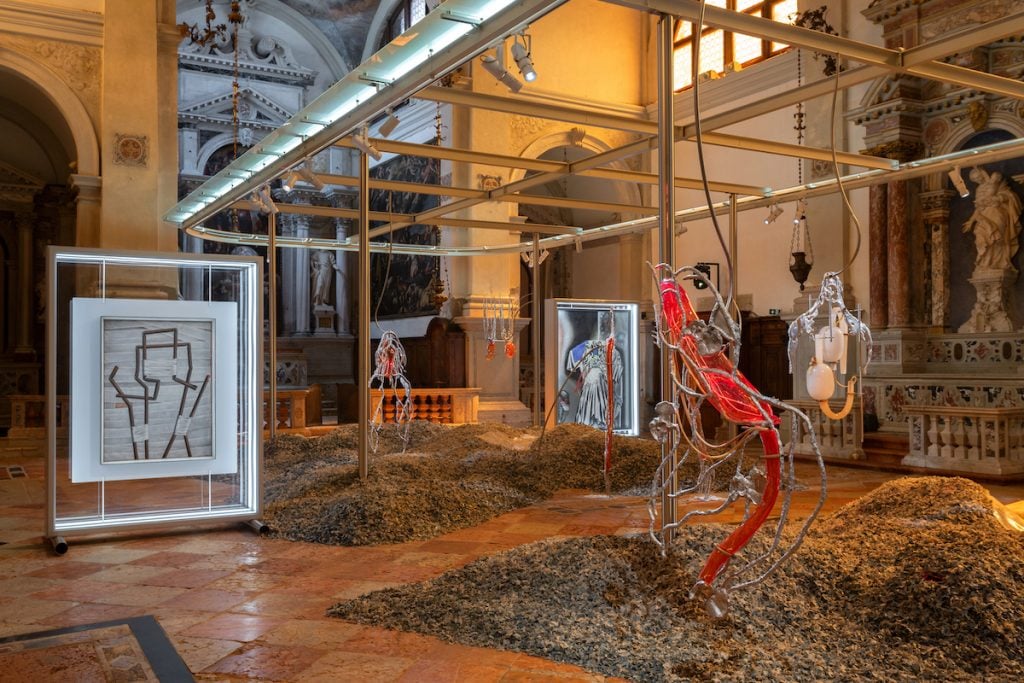
Pakui Hardware and Marija Terese Rozanskaite “Inflammation.” Lithuanian National Pavilion 2024.Photo: Ugnius Gelguda. Courtesy of the artists, Lithuanian National Museum of Art and carlier | gebauer (Berlin/Madrid), MTR art foundation
“[It] sounds like a huge contradiction, but this is the contradiction of our time,” said their gallerist, Ulrich Gebauer from Carlier Gebauer, who discovered the artists at a group exhibit in Madrid’s La Casa Encendida four years ago. “Just seeing the work and then reading the background of the name, I was immediately attracted,” he added.
In recent years, Gebauer said a wider public has begun “understanding what they are doing, and a number of curators are deeply interested.” Nevertheless, he contended “the market side is much slower, but this is very normal and I’m not afraid of that. We can sell their works to institutions, and more private collectors are becoming interested as well.”
A turning point in their recognition came with the breathtaking 2019 show, “Underbelly,” at the Museum der bildenden Künste (MdbK), Leipzig, Germany, which contained prostheses and silicone arteries bathed in suspended liquid chambers. Earlier, in 2018, the artists explored surgery in “The Return of Sweetness” at London’s Tenderpixel, in yet another show that turned heads. The duo has also exhibited in the Istanbul Biennial, the 13th Baltic Triennial in Vilnius, the BALTIC Art Center in Gateshead, UK, and the Leopold-Hoesch-Museum, Düren, to name a few. Forthcoming are several site-specific shows, including ones in France and Poland.
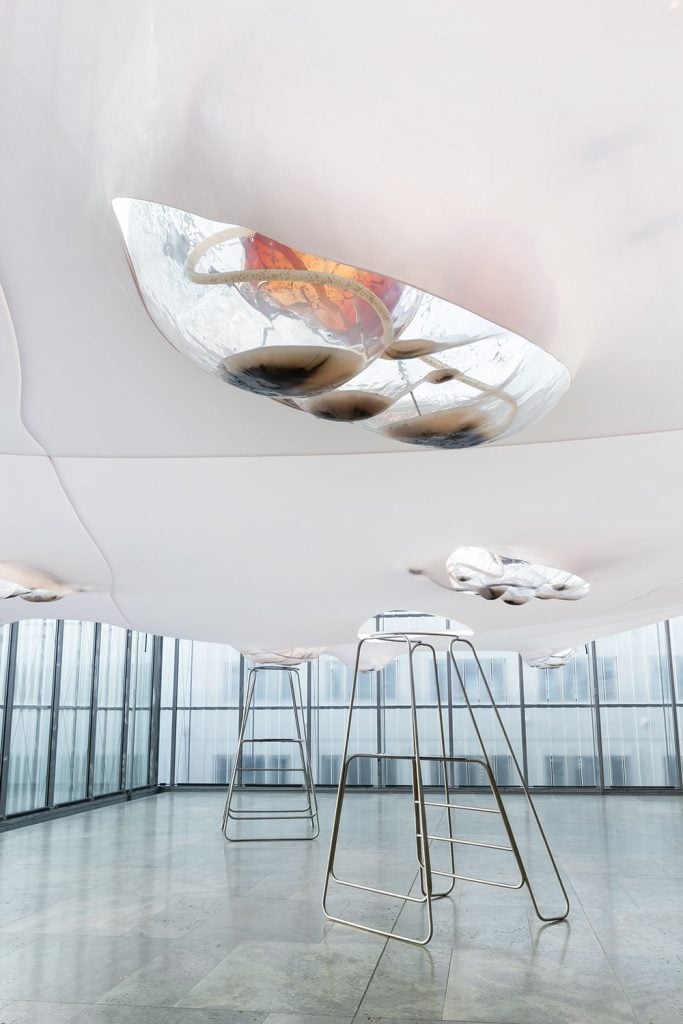
Pakui Hardware. “Underbelly” at MdbK Leipzig, Germany, 2019. Photo: Ugnius Gelguda
Courtesy the artists, Museum der Bildenden Künste, Leipzig and carlier | gebauer (Berlin/Madrid).
The Venice presentation, curated by Valentinas Klimašauskas and João Laia, behaves like a constructed body around which the visitor is invited to wander. Reddish-orange, globular glass forms bubble from aluminum skeletons, or vein-like nerves, all of which are suspended from a sterile-looking structure. Like votives brought to life, they pulse occasionally as red lasers pierce through them and onto the church walls. Underneath the suspended pieces, a thick field of recycled plastic peelings undulates throughout the church.
Also included are several paintings by the Soviet-era Lithuanian artist Marija Teresė Rožanskaitė (1933–2007). These works, made in the 1970s and 80s, have been a major inspiration for the duo. They show surreal hospital scenes ripe with symbolism—bodies stretched on gurneys, faceless figures bent over an operating table—and offer a not-so-subtle critique of the Soviet system.
Several elements of Rožanskaitė’s artworks are echoed in the installation. Additionally, a sound element was introduced to the duo’s practice with this latest work: the softened hum of an MRI scanning machine comes on and off intermittently, completing an overall effect of a throbbing alien motherboard.
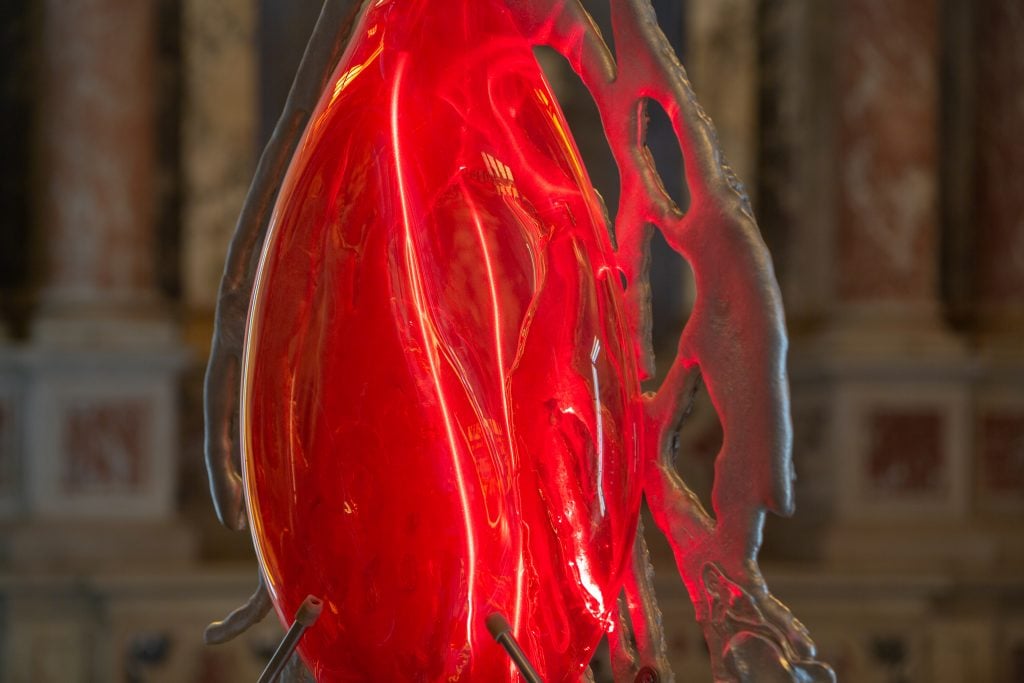
Pakui Hardware and Marija Terese Rozanskaite “Inflammation.” Lithuanian National Pavilion 2024.Photo: Ugnius Gelguda. Courtesy of the artists, Lithuanian National Museum of Art and carlier | gebauer (Berlin/Madrid), MTR art foundation
Yet we are not necessarily dealing with a nihilist sci-fi outlook. Crafted with a pervasive sense of human touch—the artists cast the aluminum themselves in rough and root-like veins—Černiauskaitė also points out the installation is not so much extra-terrestrial as it is a depiction of what goes unnoticed and is little-known.
“This is what it is inside us,” said Černiauskaitė. Inspiration for the sculptures was taken directly from a 3D map of the human nervous system. “We tend to think of our bodies like internal parts, or something very alien… But actually, it’s inside of you. This relationship to the body as something alien, even to yourself, is quite interesting to think about in relationship to this year’s Biennale theme of ‘Foreigners Everywhere,’ when you’re the foreigner yourself,” she added.
The duo has actually been thinking about it for some time. After meeting at a gallery in Vilnius some years before (both come from families “entrenched in culture,” they said), the two began focusing on medical interventions while struggling to make ends meet as young artists in New York between 2012 and 2014.
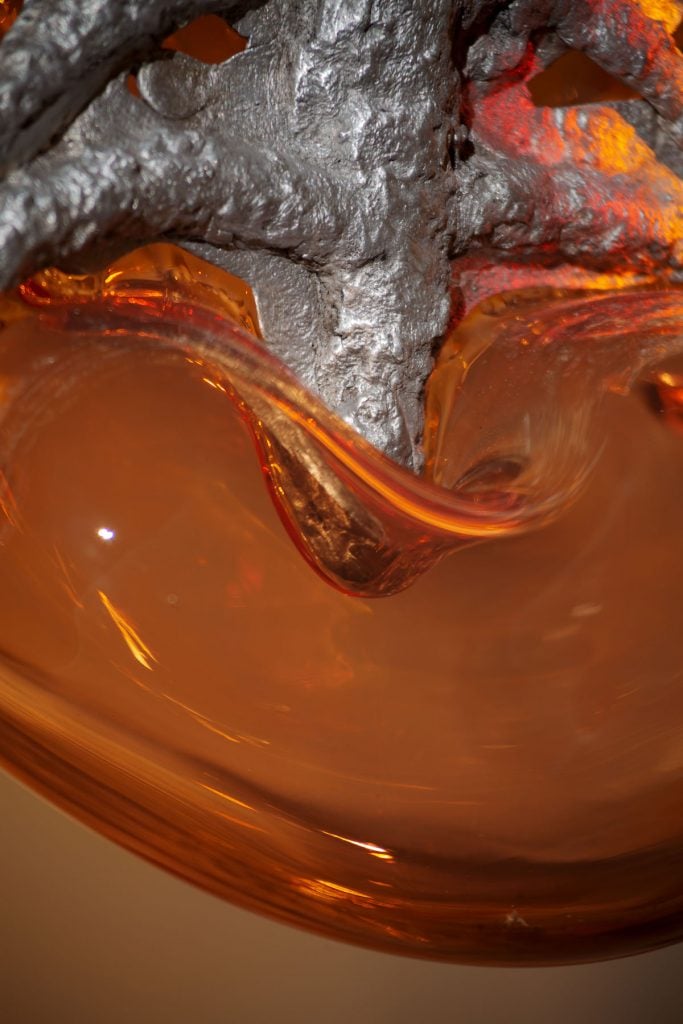
Pakui Hardware and Marija Terese Rozanskaite “Inflammation.” Lithuanian National Pavilion 2024.Photo: Ugnius Gelguda. Courtesy of the artists, Lithuanian National Museum of Art and carlier | gebauer (Berlin/Madrid), MTR art foundation
“At that time, there was this extreme rise of a kind of hyper-body,” Černiauskaitė recalled. “These enhanced bodies, hyper-fitness, superfoods, and supplements—everything was wired to become more productive and efficient.” The artists, who come from a country where healthcare is state-run, had healthcare costs to think about while in the U.S. To see “people focusing on enhancing bodies, while you are asking, ‘how do I survive here?’” was a turning point. “This discrepancy between those things was shocking.”
“When the body is ailing or something is wrong, that is when you start actually noticing it, because when the machine runs smoothly, you just don’t care,” she added. “But as soon as something goes wrong, this is when you start paying attention. Through malfunction we start understanding the importance of embodiment on a daily basis, our survival, and how things run in general.”
With more of that understanding and awareness of what ails us, the artists hope we—as individuals and as a society—may at least attempt to heal.
“Inflammation,” an installation by artist duo Pakui Hardware is on view at the Pavilion of Lithuania at the 60th International Art Exhibition, la Biennale di Venezia, presented by the Lithuanian National Museum of Art.